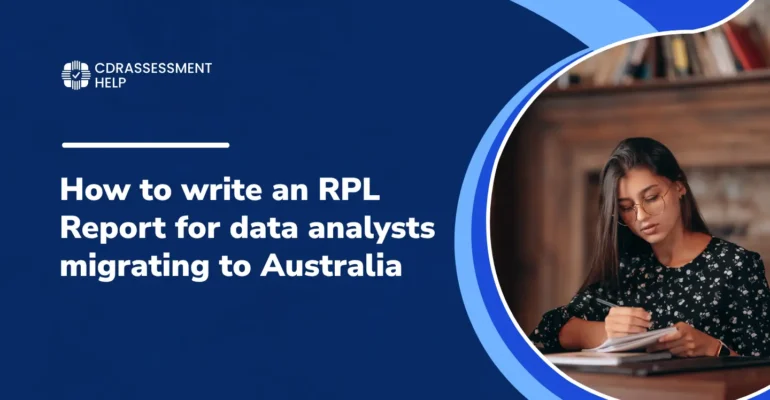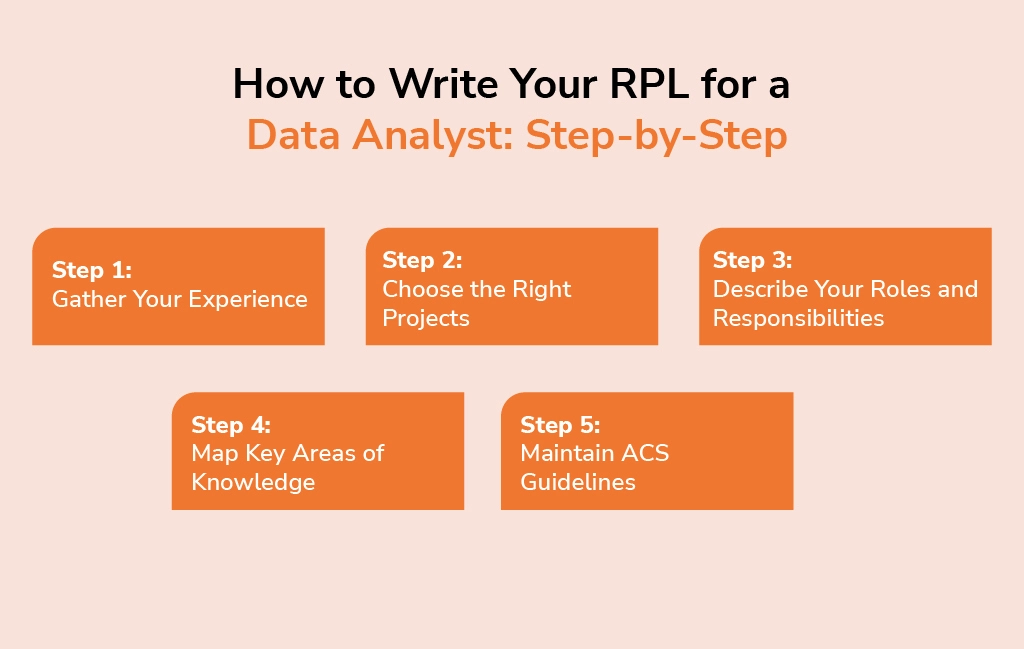How to write an RPL report for data analysts migrating to Australia

How to write an RPL report for data analysts migrating to Australia
Australia is one of the top destinations for skilled professionals looking to migrate and build a successful career. With its thriving economy and growing demand for tech expertise, Data Analysts are among the most sought-after professionals in the country.
Suppose you’re a data analyst with relevant experience but no formal ICT qualifications. In that case, you can still qualify for migration through the Recognition of Prior Learning (RPL) pathway offered by the Australian Computer Society (ACS).
In this comprehensive guide, we’ll cover everything you need to know about writing an RPL for a Data Analyst, the skill assessment process, documentation requirements, and practical tips to improve your chances of success.
🔑 Key Highlights
- Without an ICT degree, the RPL report for Data Analyst allows you to fulfil skilled migration conditions through your work experience.
- You should submit the Data Analyst RPL report to the Australian Computer Society (ACS) to establish your ICT expertise.
- Through RPL, most Data Analysts apply for 261111 (ICT Business Analyst) or 261112 (Systems Analyst) ANZSCO Codes.
- The completion of a valid RPL report for a Data Analyst position results in career opportunities, which also lead to well-compensated jobs and permanent residency options in Australia.
What is an RPL report?
Recognition of Prior Learning (RPL) is an assessment process used by the Australian Computer Society (ACS) to evaluate the skills and experience of individuals who do not hold an ICT-related degree but have relevant industry experience.
This pathway is especially designed for professionals who have acquired their knowledge through work experience, self-learning, and non-formal training. RPL report allows such candidates to demonstrate that they meet the standards required for an ICT profession under Australia’s migration criteria.
Why Choose the RPL Pathway as a Data Analyst?

If you’re a Data Analyst without a formal ICT qualification or if your degree is not closely related to ICT, you may not qualify for a direct skills assessment. The RPL pathway allows you to prove your competence and migrate to Australia as a Data Analyst.
Here are the top reasons to consider the RPL pathway:
1. Recognition of Work Experience
Your hands-on experience counts, even if you don’t have a related degree.
2. Skilled Migration Opportunity
Allows you to apply for skilled migration under the ANZSCO Code 261111 – ICT Business Analyst, or 261112 – Systems Analyst, depending on your exact role and experience.
3. Career Growth in Australia
With Australia’s booming tech industry, the demand for data analytics is at an all-time high.
ANZSCO Code for Data Analyst Australia
The ANZSCO (Australian and New Zealand Standard Classification of Occupations) provides a standardised description of occupations. For Data Analysts, the closest and most relevant codes include:
- 261111 – ICT Business Analyst
- 261112 – Systems Analyst
Both these codes are applicable depending on your job role. Data Analysts are generally involved in analysing data, generating reports, identifying trends, and helping businesses make data-driven decisions.
Data Analyst Skill Assessment Requirements
The Data Analyst skill assessment under the RPL pathway requires candidates to demonstrate proficiency in core ICT knowledge areas and relevant work experience.
Eligibility Criteria:
To be eligible for an RPL assessment, you must meet one of the following:
- Non-ICT Qualification (Bachelor’s or Higher) + 6 years of relevant work experience
- No Tertiary Qualification + 8 years of relevant work experience
Of the total experience, at least 2 years must be in a closely related ICT role performed in the last 10 years.
Documents Required for RPL for a Data Analyst
To successfully apply for the RPL assessment, submit a set of documents to ACS. These include:
- Personal Identification Documents (Passport, Birth Certificate)
- Employment References for each relevant job position
- CV/Resume with detailed roles and responsibilities
- RPL Application Form (including the RPL report)
- Two Key Project Reports
Let’s dive deeper into the most important component—the RPL Report.
Structure of the RPL Report for a Data Analyst

The ACS RPL report comprises two major components:
1. Key Areas of Knowledge
You must demonstrate your knowledge of two core ICT areas:
- Essential Core ICT Knowledge
- ICT Professional Knowledge (e.g., ethics, professional expectations, teamwork, communication)
- ICT Problem Solving (e.g., design, development, evaluation)
- General ICT Knowledge
- Technology Building
- Technology Management
- ICT Service Management
You’ll need to select two subtopics from each of the above categories and provide explanations and examples of how you’ve applied this knowledge in real-world scenarios.
2. Two Project Reports
You must submit two detailed project reports that showcase your role, responsibilities, and outcomes as a data analyst. One of the projects must be from the past 3 years, and the other can be from the last 5 years.
Each project should cover:
- Project title and description
- Roles and responsibilities
- Objectives and scope
- Tools, methods, and technologies used
- Challenges faced and how you resolved them
- Outcomes and success metrics
- Team collaboration and leadership involvement
How to Write Your RPL for a Data Analyst: Step-by-Step

Step 1: Gather Your Experience
Start by collecting information on all your relevant work experience. List out:
- Job titles
- Employers and periods of employment
- Job roles and duties
- Projects worked on
- Technologies and tools used: SQL, Python, Tableau, R, Excel, etc.)
Step 2: Choose the Right Projects
Select two projects where you significantly contributed as a Data Analyst. Choose projects that showcase your abilities in data extraction, cleansing, analysis, modeling, and business reporting.
Step 3: Describe Your Roles and Responsibilities
Be detailed. Focus on tasks that align with the ANZSCO definition of a Data Analyst. Include:
- Data collection and cleaning
- Using statistical tools
- Interpreting data trends
- Creating dashboards and reports
- Communicating insights to stakeholders
Step 4: Map Key Areas of Knowledge
Relate your experiences in the projects to the key ICT knowledge areas as required by ACS. Use examples to demonstrate your understanding and practical application.
Step 5: Maintain ACS Guidelines
- Avoid plagiarism.
- Follow the RPL report format as per ACS guidelines.
- Stick to the word count and documentation checklist.
Example Project Summary for a Data Analyst
Here’s a short excerpt from a sample project summary:
Project Title: Sales Data Optimization for Retail Chain
Employer: ABC Retail Pvt. Ltd.
Duration: Jan 2021 – Dec 2022
Tools Used: SQL, Power BI, Python
Responsibilities:
- Extracted sales data from multiple sources and cleaned it for consistency.
- Used Python libraries (Pandas, NumPy) for data wrangling.
- Built interactive dashboards using Power BI for the executive team.
- Conducted correlation analysis to identify buying trends.
- Recommended inventory adjustments based on predictive insights.
Outcome:
Helped reduce overstocking by 23% and improved revenue forecasting accuracy by 15%.
Common Mistakes in RPL for Data Analyst Submissions
- Submitting copied content: ACS uses Turnitin to detect plagiarism.
- Inadequate technical depth: Vague or generic project descriptions often lead to rejection.
- Failing to match the ANZSCO code: Ensure your job responsibilities align with those of a data analyst under Australian standards.
- Incorrect format: Not following the RPL structure can cause delays or rejection.
Tips to Ace Your RPL for a Data Analyst
- Use specific metrics: Instead of saying “Improved efficiency,” say “Reduced data processing time by 40%.”
- Mention tools and technologies: Show your familiarity with industry-standard tools.
- Tailor your report: Match your content with the selected ANZSCO code.
- Seek professional review: Have your RPL reviewed by experts familiar with ACS requirements.
Opportunities for Data Analysts in Australia
Once you successfully clear the Data Analyst skill assessment, you can explore a range of job opportunities across various sectors in Australia:
- IT and Software Companies
- Retail and E-commerce
- Finance and Insurance
- Healthcare
- Public Sector and Government Analytics
Average salaries for Data Analysts in Australia range from AUD 90,000 to AUD 130,000 per year, with higher earning potential as experience grows.
PR Pathway for Data Analysts in Australia
After passing your RPL and ACS skill assessment, you can apply for skilled migration visas like:
- Subclass 189 – Skilled Independent Visa
- Subclass 190 – Skilled Nominated Visa
- Subclass 491 – Skilled Work Regional (Provisional) Visa
Ensure you also meet the other requirements, such as English proficiency (IELTS/PTE), health checks, and character assessments.
Conclusion
Preparing an RPL for a Data Analyst is not just about filling in a form—it’s about telling your professional story in a compelling, structured, and evidence-backed way.
With a clear understanding of the Data Analyst skill assessment process and a well-prepared RPL report, your journey to becoming a Data Analyst in Australia becomes much smoother.
If you’re unsure or need guidance, consider consulting professionals who specialise in preparing RPL reports for ACS assessments. A small investment today can save you from rejection and put you on the fast track to your dream life in Australia.
Frequently Asked Questions (FAQs)
Q1: Do I need an ICT degree to apply for a Data Analyst role in Australia?
Not necessarily. You can apply via the RPL pathway if you have sufficient relevant work experience.
Q2: How many years of experience do I need for the RPL pathway?
6 years if you have a non-ICT degree, or 8 years if you have no tertiary qualifications.
Q3: What happens if my RPL is rejected?
You can revise and resubmit, but it’s best to consult with an expert to ensure your next submission is successful.
Q4: Can I include freelance or self-employed work?
Yes, but you’ll need to provide verifiable evidence such as contracts, invoices, or client testimonials.
